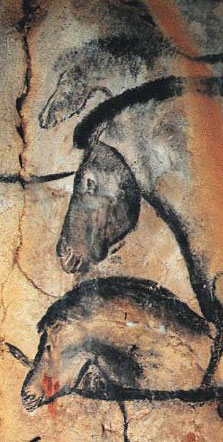- Relief printing
- Intaglio and planographic printing
- Color printing
- Bits and pieces
- Early photography in silver
- Non-silver processes
- Modern photography
- Color notes
- Color photography
- Photography in ink: relief and intaglio printing
- Photography in ink: planographic printing
- Digital processes
- Where do we go from here?
Cave walls
 Pigment prints. Artist unknown. Hands from the walls of the Chauvet cave, Ardèche, France. c. 30,000 B.C. © Jean-Marie Chauvet, Eliette Brunel Deschamps, and Christian Hillaire.
Pigment prints. Artist unknown. Hands from the walls of the Chauvet cave, Ardèche, France. c. 30,000 B.C. © Jean-Marie Chauvet, Eliette Brunel Deschamps, and Christian Hillaire.
Mixed in with the hand-drawn pictures in the caves are clear examples of printing. The most common of these printed pictures are of the human hand. Sometimes the image is dark, obviously made by impressing a pigment-covered hand onto the wall, while in other cases the hand appears as a negative, clear but surrounded by colored material. The hands we find in prehistoric caves represent two of the fundamental forms of the basic types of printing. The positive images (those made by the hand itself carrying the pigment) are examples of relief printing, the system that underlies printing with moveable type or with wood or linoleum blocks. The negative images (those blank hands surrounded by colored pigment) are examples of stencil printing, in which image-bearing pigment is passed through or around some form that holds the picture information.

Pigment prints. Artist unknown. Horses from the walls of the Chauvet cave, Ardèche, France. c. 30,000 B.C. © Jean-Marie Chauvet, Eliette Brunel Deschamps, and Christian Hillaire.

